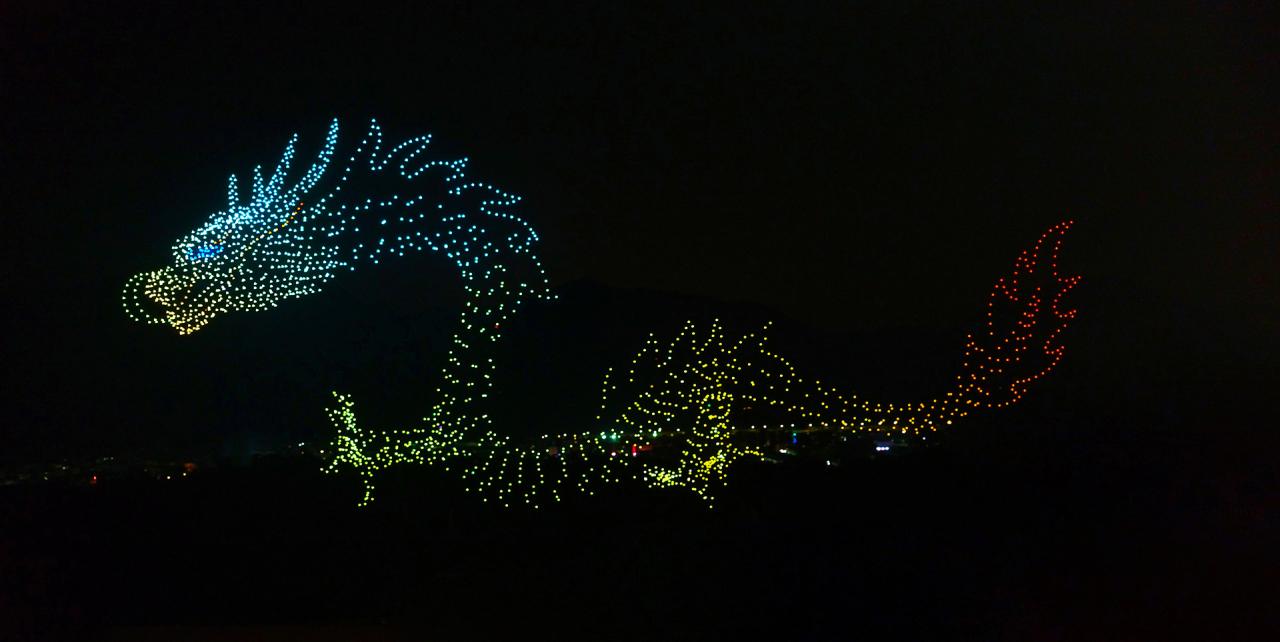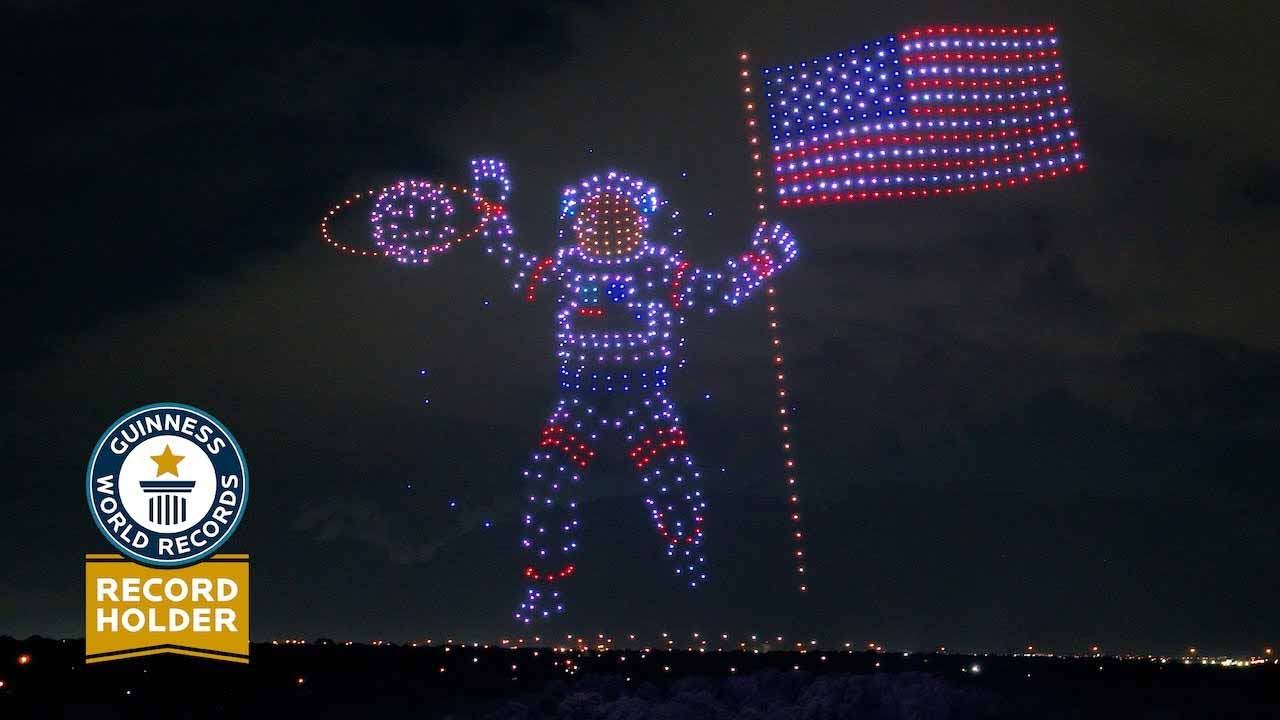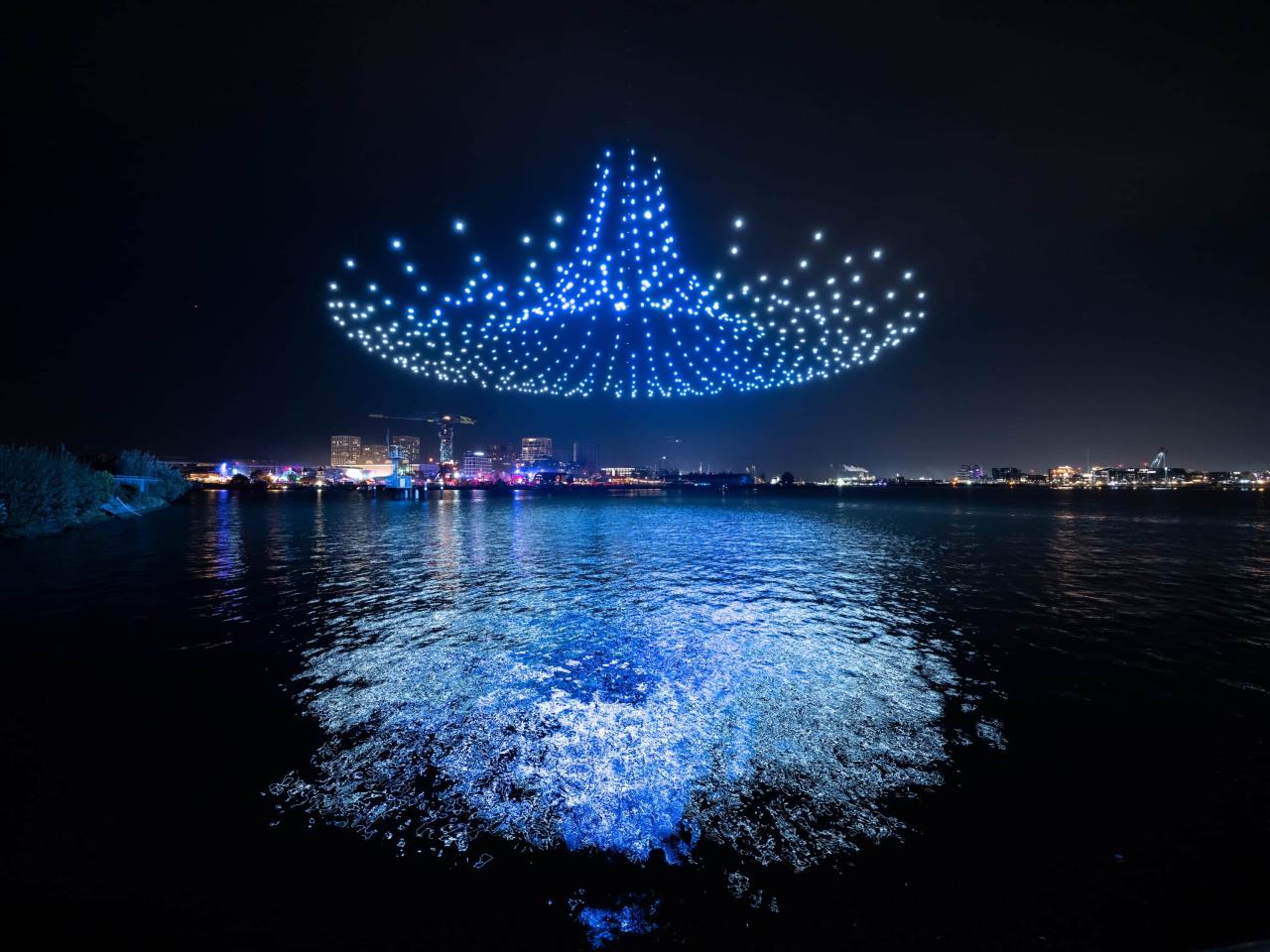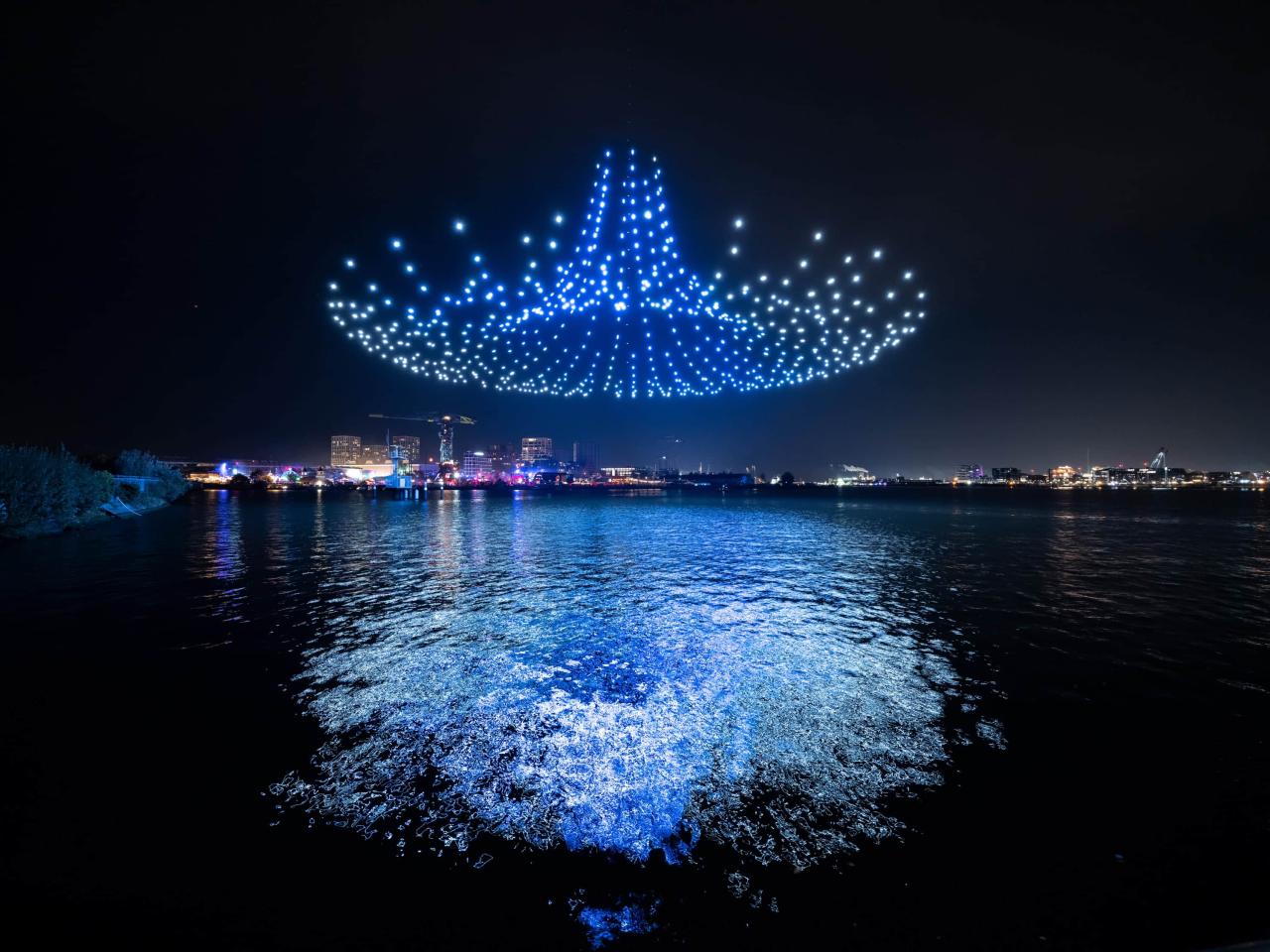Drone shows: Imagine a breathtaking spectacle of hundreds of drones painting vibrant pictures across the night sky, synchronized to music and telling a captivating story. This isn’t science fiction; it’s the rapidly evolving world of drone light shows, a captivating blend of technology, artistry, and spectacle. We’ll explore the technology behind these mesmerizing displays, the creative processes involved in their design, and the safety and business aspects of bringing these awe-inspiring events to life.
From the intricate choreography and dazzling light effects to the complex technology and safety regulations, we’ll delve into every aspect of creating a successful drone show. We’ll cover everything from choosing the right drones and software to marketing your show and ensuring a safe and unforgettable experience for your audience. Get ready to take flight into the exciting world of drone shows!
Drone Show Technology
Drone shows rely on sophisticated technology to create breathtaking aerial displays. This section delves into the key technological components enabling these mesmerizing performances.
Drone Types in Drone Shows
Various drone types are employed, each with specific capabilities. Common choices include quadcopters, due to their stability and maneuverability, and hexacopters, offering increased redundancy and flight time. The selection depends on the show’s scale, complexity, and desired effects.
Flight Control Systems and Software

Precise coordination of numerous drones requires advanced flight control systems and software. These systems utilize GPS, IMU (Inertial Measurement Unit), and other sensors to track each drone’s position and orientation. Sophisticated algorithms ensure smooth, synchronized movements, even in challenging conditions.
Communication Protocols
Real-time control and synchronization necessitate robust communication protocols. Common methods include proprietary radio frequency (RF) systems, offering high bandwidth and low latency. These protocols enable rapid transmission of commands and data between the ground control station and individual drones.
Drone Lighting Technologies
LED and RGB lighting technologies are prevalent in drone shows. LEDs offer high brightness and efficiency, while RGB LEDs provide a wider color gamut, enabling vibrant and dynamic displays. The choice depends on the desired visual impact and budget constraints.
Improving Drone Show Precision and Responsiveness
A hypothetical system for enhancing precision and responsiveness could incorporate advanced sensor fusion, integrating data from multiple sensors (GPS, IMU, cameras) for more accurate positioning. Predictive algorithms could anticipate and compensate for wind gusts and other environmental factors, leading to smoother, more responsive movements.
Drone Show Design and Choreography

Transforming a creative vision into a captivating drone show involves meticulous planning and choreography. This section explores the creative and technical aspects of bringing a drone show to life.
Sample Choreography: A Celestial Journey (5-minute show)
This choreography depicts a journey through space. The transitions between scenes are smooth and visually compelling, using the drones’ movements and lighting to create a sense of wonder.
- Scene 1: Launch sequence – drones ascend in a synchronized pattern, forming a single point of light.
- Scene 2: Earthrise – drones create an image of the Earth, gradually zooming out to show its curvature.
- Scene 3: Journey through the Milky Way – drones form swirling patterns representing the Milky Way galaxy.
- Scene 4: Encounter with a nebula – drones create a vibrant nebula, changing colors and shapes.
- Scene 5: Return to Earth – drones descend in a graceful pattern, forming a final image before landing.
Visual Effects Achievable with Drones
Drones can create a wide range of visual effects. These include geometric patterns, complex shapes, 3D structures, and text displays. The possibilities are virtually limitless, constrained only by imagination and technological capabilities.
Integrating Music and Sound Effects
Synchronizing drone movements with music and sound effects significantly enhances the emotional impact. Careful selection and precise timing create a cohesive and immersive experience for the audience.
Translating Concept to Flight Plan

The process involves several steps: initial concept development, storyboard creation, choreography design using specialized software, and flight path generation. Each step requires collaboration between creative directors, programmers, and drone pilots.
Creating a 3D Model for Pre-visualization
Creating a 3D model allows for visualization of the entire choreography before the actual performance. This allows for adjustments and improvements, reducing risks and ensuring a polished final product. Software like Blender or specialized drone show planning software can be used.
Drone Show Safety and Regulations
Safety and regulatory compliance are paramount in drone shows. This section Artikels crucial safety measures and regulatory considerations.
Potential Safety Hazards and Mitigation Strategies
Potential hazards include drone malfunctions, collisions, unexpected weather conditions, and audience safety. Mitigation involves rigorous pre-flight checks, redundant systems, weather monitoring, and designated safety zones.
Regulatory Requirements and Licensing
Regulations vary by region. Generally, operators need permits, licenses, and insurance. Compliance involves understanding local airspace restrictions, obtaining necessary approvals, and adhering to all applicable regulations.
Emergency Protocols
Emergency protocols include procedures for handling drone malfunctions (e.g., failsafe mechanisms, emergency landing procedures) and system failures (e.g., communication loss, power outages). These protocols should be thoroughly tested and practiced.
Risk Assessment Methodologies
Risk assessment involves identifying potential hazards, evaluating their likelihood and severity, and implementing control measures. Methods include HAZOP (Hazard and Operability Study) and FMEA (Failure Mode and Effects Analysis).
Safety Regulations Checklist
A pre-show checklist should cover all aspects of safety, including pre-flight inspections, weather monitoring, emergency response planning, and post-show review. This ensures a safe and compliant performance.
Drone Show Business and Marketing
The success of a drone show business depends on effective marketing and a sound business model. This section Artikels key aspects of establishing and growing a successful drone show enterprise.
Marketing Plan for Corporate Events and Festivals
A marketing plan should target specific audiences. For corporate events, emphasize the unique branding opportunities and visual impact. For festivals, highlight the entertainment value and spectacle. Utilizing high-quality videos and photos showcasing past performances is crucial.
Revenue Models
Revenue models include direct ticket sales (for public shows), sponsorships (from businesses wanting brand visibility), and licensing (selling show designs or technology to other operators). A diversified revenue stream reduces reliance on any single income source.
Social Media and Online Promotion
Social media platforms like Instagram, Facebook, and YouTube are vital for showcasing the visual appeal of drone shows. Engaging content, behind-the-scenes glimpses, and interactive elements can increase reach and engagement.
Cost Factors in Drone Show Production
Costs include drone acquisition and maintenance, software licenses, pilot salaries, insurance, permits, and marketing expenses. Accurate budgeting is essential for profitability.
Drone Show Performance Contract
A contract should clearly define the scope of work, payment terms, liability, insurance requirements, and cancellation policies. Legal consultation is advisable to ensure a comprehensive and legally sound agreement.
| Item | Description | Cost | Notes |
|---|---|---|---|
| Drone Rental | Number of drones and rental duration | Varies | Negotiable based on quantity and duration |
| Pilot Fees | Number of pilots and show duration | Varies | Includes travel and accommodation if necessary |
| Software Licenses | Software used for choreography and flight control | Varies | One-time or recurring fees |
| Insurance | Liability and property damage insurance | Varies | Essential for risk mitigation |
Drone Show Creative Aspects
The creative vision is the heart of a successful drone show. This section explores how artistic direction, storytelling, and audience interaction contribute to an unforgettable experience.
Innovative Drone Show Designs
Innovative designs often push the boundaries of what’s possible. Examples include: a show depicting a dynamic ecosystem with shifting landscapes, a performance that tells a historical narrative through symbolic imagery, and a show where drones transform into various objects and characters throughout the performance.
- Dynamic Ecosystem: Drones form and transform into various animals and plants, depicting a vibrant ecosystem.
- Historical Narrative: Drones depict key moments and figures from a historical event, telling a compelling story.
- Transformative Objects: Drones morph into different objects and characters, creating surprise and wonder.
Storytelling Techniques
Effective storytelling employs narrative structure, character development (through visual representation), and emotional arcs to engage the audience. The choreography should build tension, create climaxes, and offer a satisfying resolution.
Artistic Direction and Collaboration
Artistic direction guides the creative vision, ensuring consistency and coherence. Collaboration between programmers, choreographers, musicians, and lighting designers is essential for a unified and impactful show.
Impact of Lighting Design and Color Palettes
Lighting design significantly influences the mood and atmosphere. Strategic use of color palettes can evoke specific emotions, enhance visual effects, and create depth and dimension.
Incorporating Audience Interaction
Audience interaction can elevate the experience. This could involve using audience input to influence the show’s progression, or creating interactive elements where the audience’s actions affect the drone display.
Closure

Drone shows are more than just a display of technology; they are a powerful form of visual storytelling, capable of captivating audiences and leaving a lasting impression. The combination of advanced technology, creative choreography, and meticulous planning creates an experience that transcends the ordinary. As technology continues to advance and creative boundaries are pushed, the future of drone shows promises even more breathtaking and innovative displays.
So, whether you’re a budding entrepreneur, a creative artist, or simply a captivated spectator, the world of drone shows offers a captivating journey into the future of entertainment.
FAQ Compilation
How much does a drone show cost?
The cost varies greatly depending on factors like the number of drones, show duration, complexity of choreography, and location. Expect a significant investment.
What kind of permits are needed for a drone show?
Permits and licenses vary by location. You’ll need to check with local aviation authorities and potentially obtain airspace permits well in advance.
How long does it take to plan a drone show?
Planning can take several weeks or even months, depending on the scale and complexity of the show. Choreography, software programming, and safety checks all take time.
What happens if a drone malfunctions during a show?
Comprehensive safety protocols and backup systems are crucial. Most systems have fail-safes, and operators are trained to handle emergencies.
